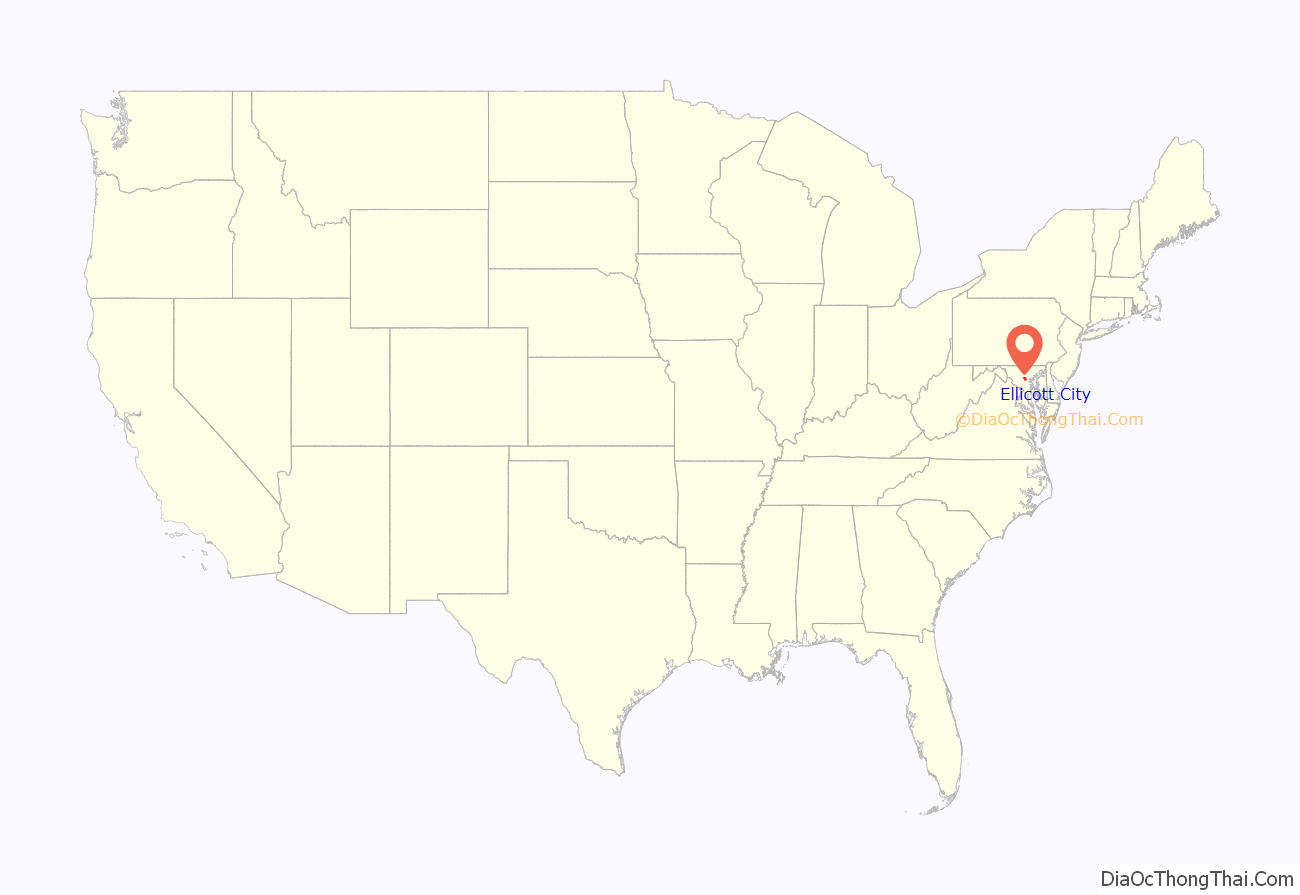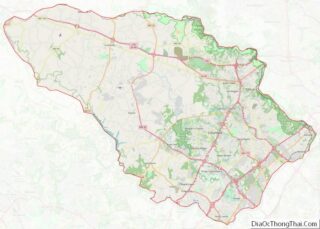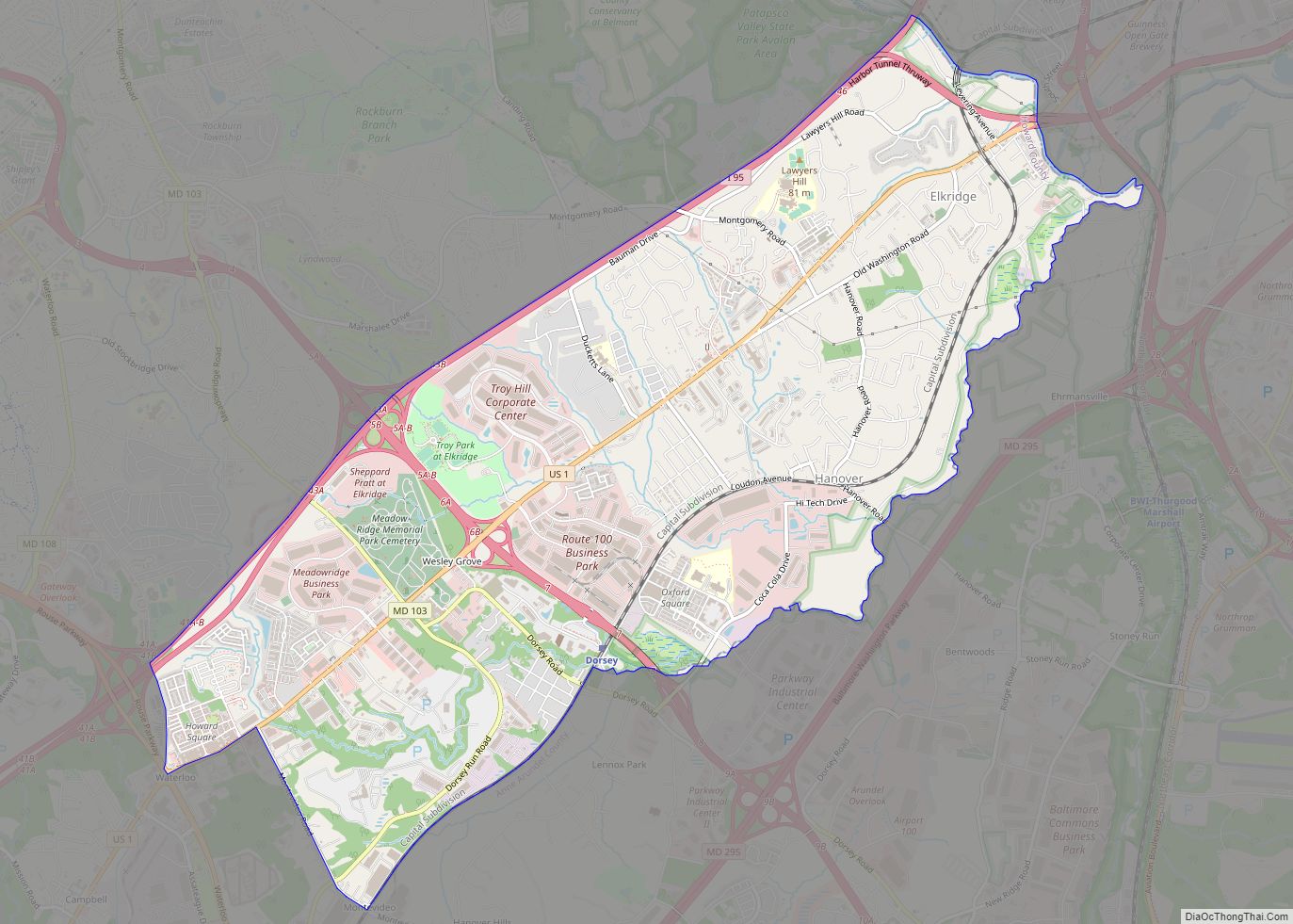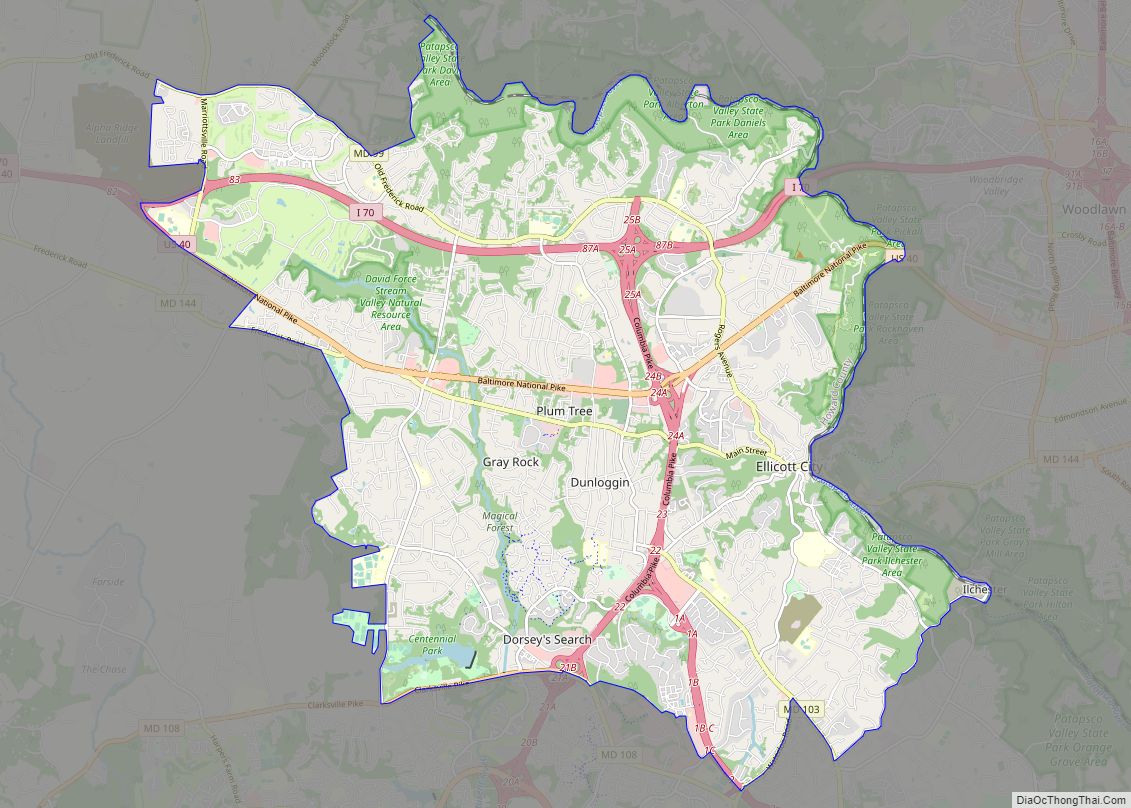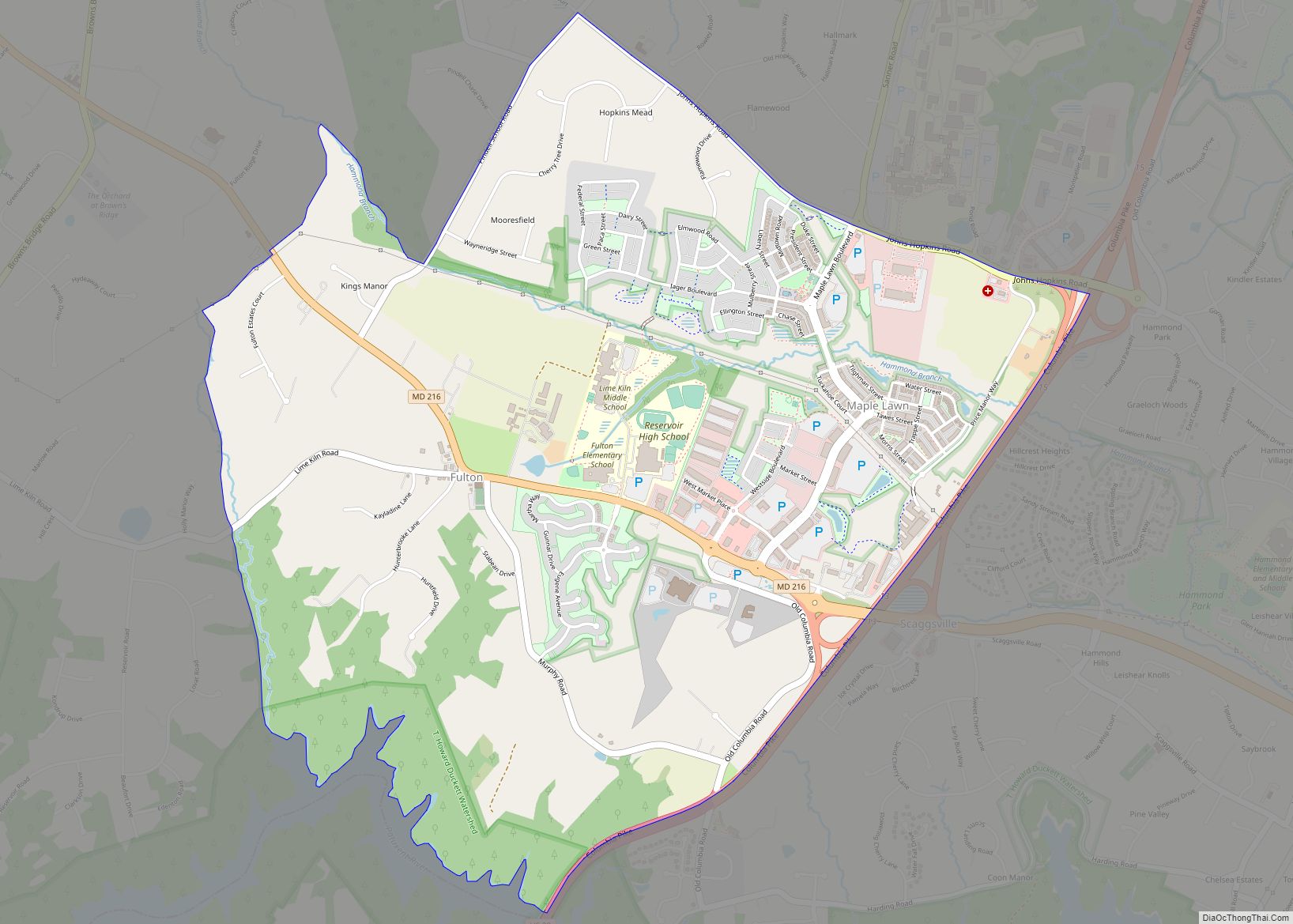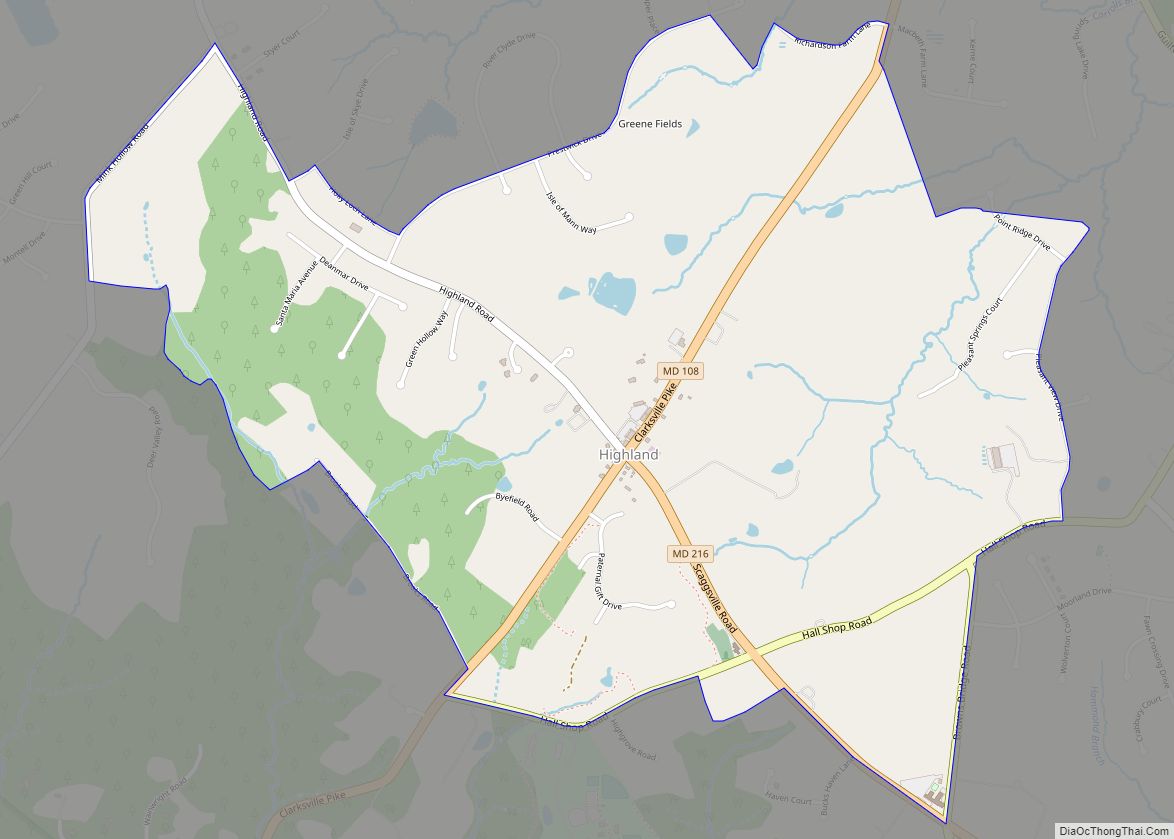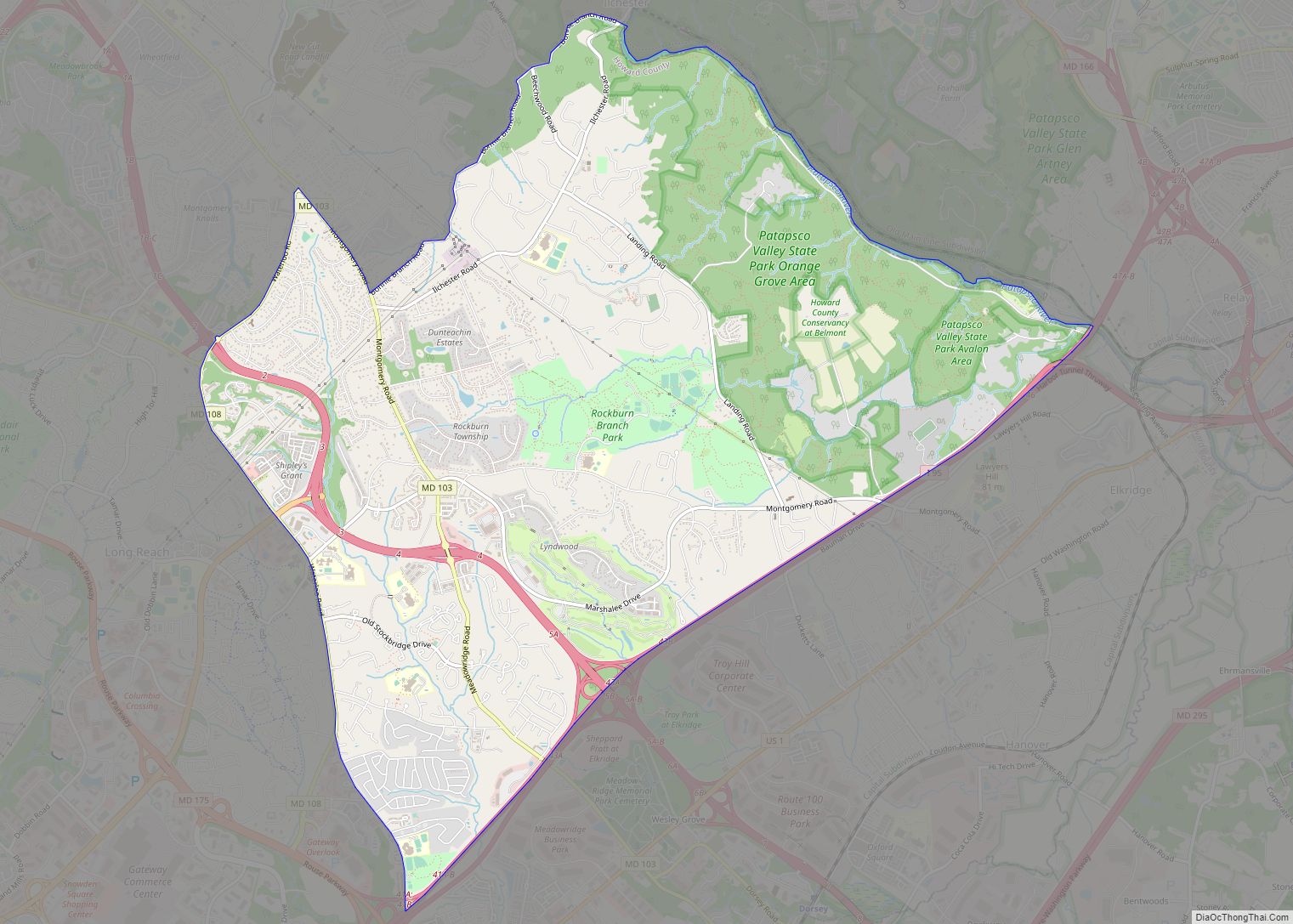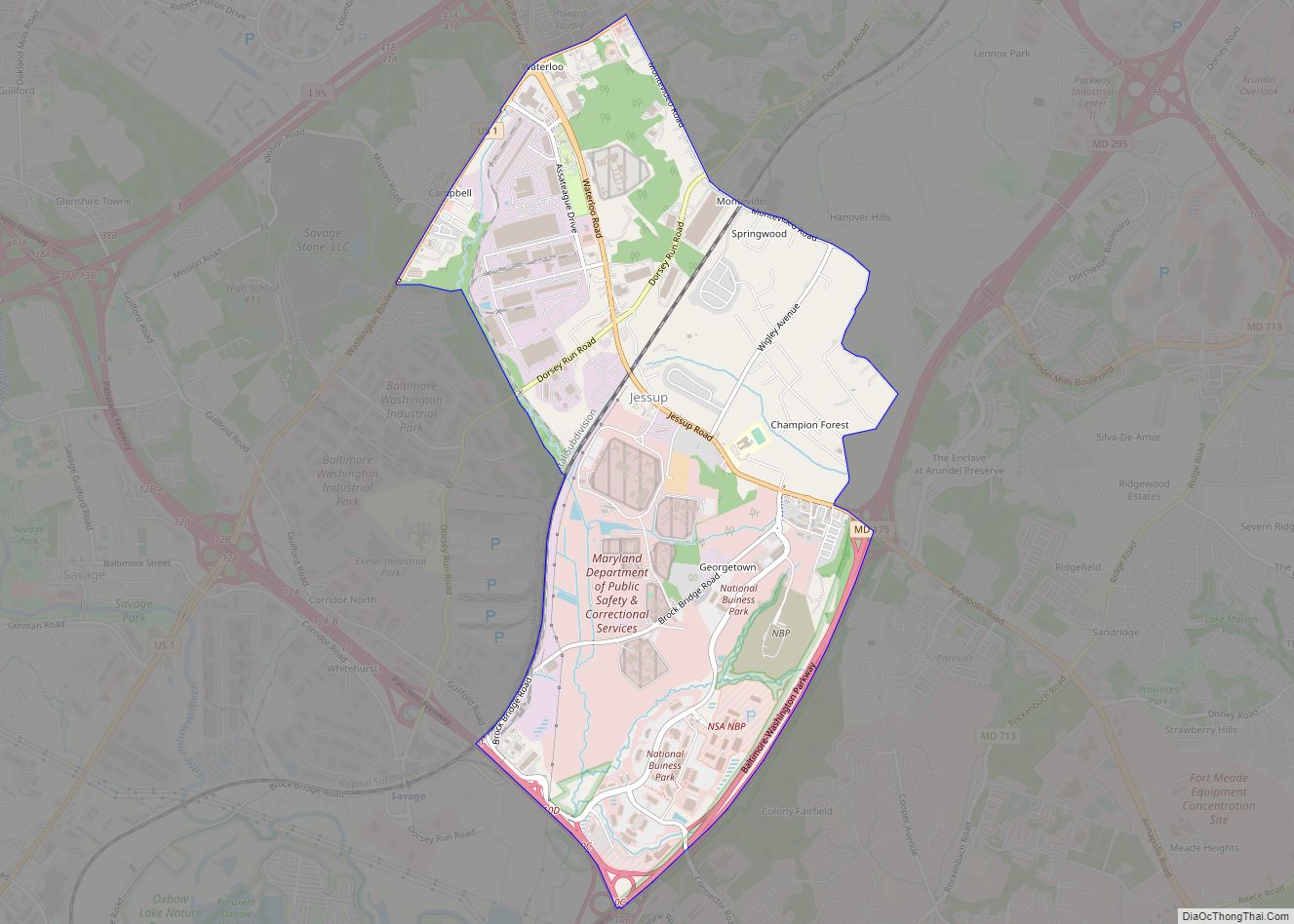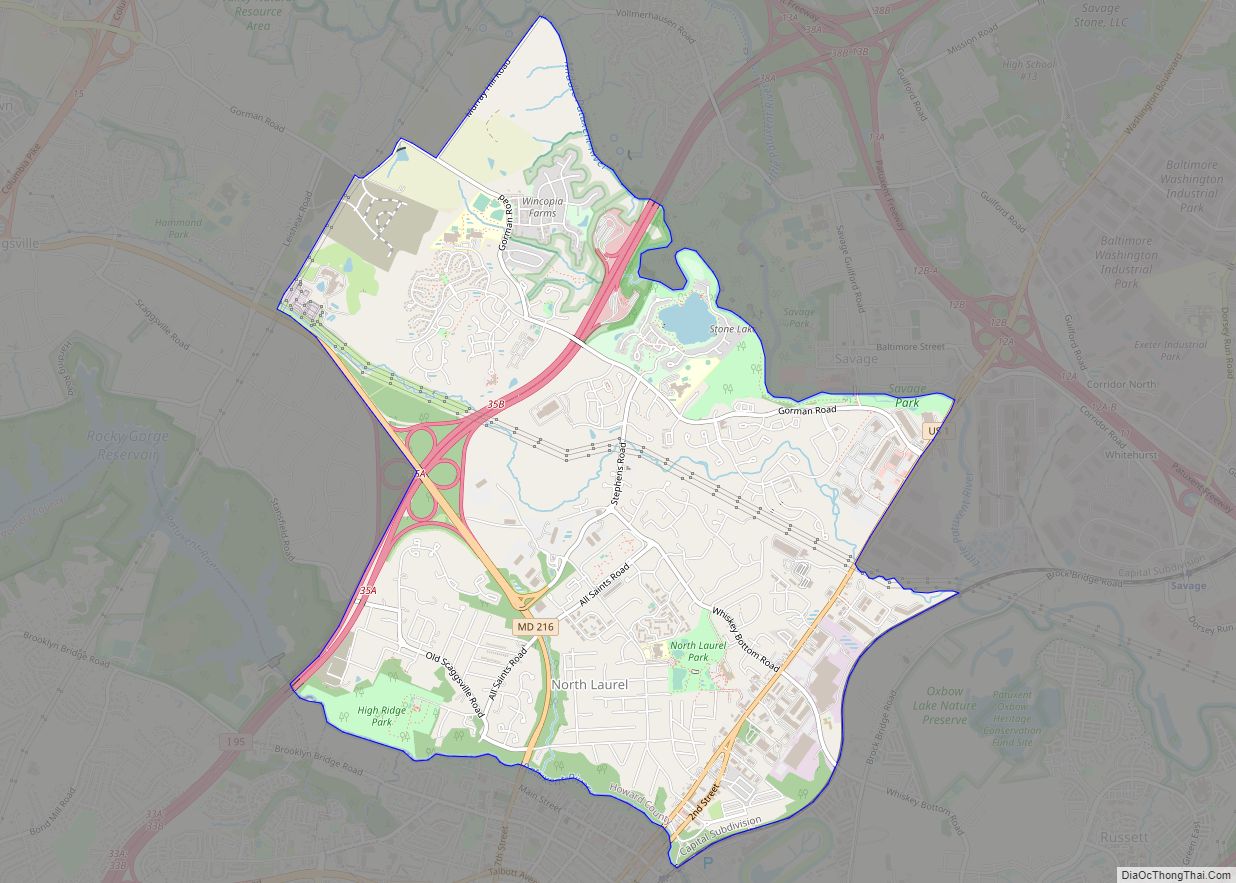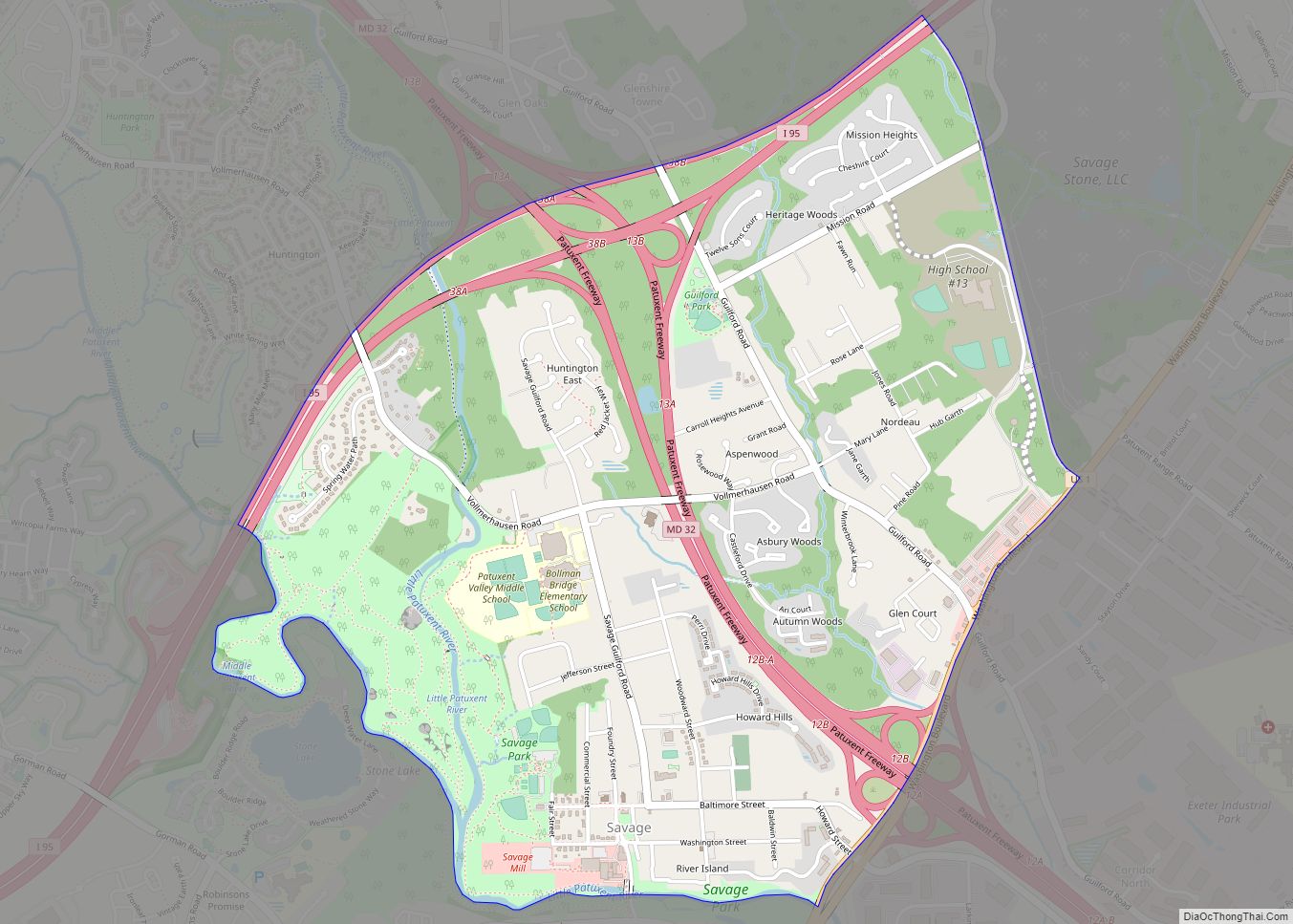Ellicott City is an unincorporated community and census-designated place in, and the county seat of, Howard County, Maryland, United States. Part of the Baltimore metropolitan area, its population was 65,834 at the 2010 census, making it the most populous unincorporated county seat in the country.
Ellicott City’s historic downtown – the Ellicott City Historic District – lies in the valleys of the Tiber and Patapsco rivers. The historic district includes the Ellicott City Station, which is the oldest surviving train station in the United States, having been built in 1830 as the first terminus of the original B&O Railroad line. The historic district is often called “Historic Ellicott City” or “Old Ellicott City” to distinguish it from the surrounding suburbs that extend south to Columbia and west to West Friendship.
| Name: | Ellicott City CDP |
|---|---|
| LSAD Code: | 57 |
| LSAD Description: | CDP (suffix) |
| State: | Maryland |
| County: | Howard County |
| Founded: | 1772 |
| Incorporated: | 1867–1935 |
| Elevation: | 180 ft (55 m) |
| Total Area: | 30.13 sq mi (78.04 km²) |
| Land Area: | 30.01 sq mi (77.72 km²) |
| Water Area: | 0.12 sq mi (0.32 km²) |
| Total Population: | 75,947 |
| Population Density: | 2,530.98/sq mi (977.22/km²) |
| Area code: | 410, 443, and 667 |
| FIPS code: | 2426000 |
| GNISfeature ID: | 0584282 |
Online Interactive Map
Click on ![]() to view map in "full screen" mode.
to view map in "full screen" mode.
Ellicott City location map. Where is Ellicott City CDP?
History
Milling
In 1766, James Hood used the “Maryland Mill Act of 1669” to condemn 20 acres (8.1 ha) for a mill site adjacent to his river-side 157-acre (64 ha) property. His gristmill was built on the banks of the Patapsco River where the Frederick road (later known as the National Road, then U.S. Route 40, then Maryland Route 144) crossed the river. The site was later known as “Ellicott’s Upper Mills”. His son Benjamin rebuilt the corn grinding mill after one of the frequent Patapsco floods in 1768. Benjamin Hood then sold the mill to Joseph Ellicott in 1774 for 1,700 pounds. In later years the B&O Railroad ran through the property, with track laid over the graves of the Hood family.
On 24 April 1771, three Quaker brothers from Bucks County, Pennsylvania, north of Philadelphia, chose the picturesque wilderness several miles upriver from Elk Ridge Landing (today’s Elkridge, Maryland), the uppermost part of the river then navigable by tobacco-loading sailing merchant ships in the 18th century, to establish a flour mill, purchasing 50 acres (20 ha) of Baltimore County land from Emanuel Teal and 35 acres (14 ha) from William Williams. In 1775 they expanded their holdings with 30.5 acres (12.3 ha) from Bartholomew Balderson and Hood’s Mill. John, Andrew, and Joseph Ellicott founded “Ellicott’s Mills”, which became one of the largest milling and manufacturing towns in the East. Nathaniel sold his partnership in 1777, and Joseph sold all but his Hood’s Mill ownership the next year. The town retained the name “Ellicott’s Mills” when the U.S. Postal stop opened on October 7, 1797.
The Ellicott brothers constructed sawmills, smithies, stables, an oil mill, a grain distillery, and grain mills. They helped revolutionize farming in the area by persuading farmers to plant wheat instead of tobacco and also by introducing Plaster of Paris fertilizer to revitalize depleted soil. The Ellicotts produced the product until a fire on 11 January 1809. Charles Carroll of Carrollton (1737-1832), the last surviving signer of the Declaration of Independence, a rare Roman Catholic and a wealthy landowner with the largest fortune then in colonial America, was an early influential convert from tobacco to wheat. By 1830, the founders’ families could no longer support operations as “Ellicott and Company” or “Johnathan Ellicott and Sons”. By 1840, the Ellicott family sold off their interests in the two flour mills, the granite quarry, the saw mill and plaster mill.
Rail
In 1830, Ellicott’s Mills became the first terminus of the Baltimore and Ohio Railroad outside Baltimore, the first commercially operated cargo and passenger railroad in the country. The B&O was organized in 1827 and had its “first stone” laid the following year with major ceremonies on July 4, Independence Day, with the beginning of construction. The Ellicott City Station, built on an embankment across the corner of the town and along the Patapsco River and intersecting Tiber Creek stream, with its “Oliver Viaduct”, named for a B&O board member Robert Oliver crossing over the National Road of large blocks of locally quarried gray granite, stands today as a living history museum, and has been designated a National Historic Landmark by the U.S. Department of the Interior, administered by the National Park Service. It bears the designation as the “Oldest surviving railroad station in America”. In 1829, New York industrialist and Baltimore foundry-owner Peter Cooper began testing his iron steam engine, Tom Thumb (1791-1883), on the B&O Railway. This was the first time a steam locomotive was used to transport persons over rails in the United States. The famous race between Tom Thumb and a horse-drawn rail carriage took place between Relay Junction on the return trip from Ellicott’s Mills towards Baltimore in August 1830. Even though the horse won the race due to a sudden broken drive belt on the Tom Thumb, it heralded the time when steam engines steadily improved, and the soon-to-be steam-operated railroad became a vital link in the town’s economy and later expanding to the city of Baltimore’s economic supremacy along with the state in the nation.
The site of the Howard County Courthouse, which was built from 1840 to 1843 in the former western Howard District of Anne Arundel County, Maryland, was so designated for the new temporary district in 1839, and continued and was expanded later when Howard County became an official independent jurisdiction in 1851, as one of the 23 counties (plus Baltimore as an independent city) in the state of Maryland. The town in 1851 was in a spate of depression as low costs shut the Maryland Machine Manufacturing Company. Over 80 vacant dwellings lined the Howard County side of the river. By 1861, Ellicott’s Mills was a prosperous farming and manufacturing area.
At the start of the Civil War on April 19, 1861, “Gaithers Raiders”, part of the Confederate “Howard County Dragoons” from Oakland Manor, marched through Ellicott’s Mills to Baltimore, responding to the Baltimore riot of 1861, before heading south to join J. E. B. Stuart. Later that month, Union Army troops seized the “Winans Steam Gun” which had been en route to Harpers Ferry, Virginia, at Ellicott’s Mills. The experimental gun had been developed by local Southern-sympathizer railroad builder and industrialist Ross Winans. In the fall of 1862, the 12th New Jersey Volunteer Infantry was assigned to guard Ellicott’s Mills, setting up the 1,200-man Camp Johnson on the lawn of the nearby Patapsco Female Institute. On July 10, 1864, the third Confederate invasion of the North, led by General Jubal Early, forced the retreat of the Federal troops under the command of General Lew Wallace down the National Pike from the Battle of the Monocacy to the B.& O.’s Ellicott’s Mills station and to Baltimore. The one-day delay by Wallace’s small force at Monocacy Junction enabled Lt. Gen. Ulysses S. Grant to rush troops in time to defend the U.S. capital. Homes and churches in Ellicott’s Mills were temporarily used as hospitals for the Union wounded.
In 1866, cholera broke out. In the same year, the Granite Mills cotton factory owned by Benjamin Detford burned down.
Incorporation and disincorporation
In 1867, a city incorporation charter was secured for Ellicott’s Mills forming a local government with a mayor and council, and the name was changed to “Ellicott City”.
The first mayor was E. A. Talbot, who lived in a stone house and operated a lumber yard at the base of the river. His business was washed away in the flood of 1866, and again in 1868. He was offered a clear title on his home from his opponent Issacs if he threw his reelection, which he did. Talbot relocated uphill to a brick and granite store designed by Charles Timanus that houses the Ellicott City Brewing Company today.
Howard County built its first jailhouse, the Ellicott City Jail, also called Emory Jail or Willow Grove, on Emory Avenue in 1878. The stone jail intended for 12 inmates operated until the Howard County Detention Center opened in 1983.
In 1879, political gangs controlled the polling locations, shooting and wounding African American Ellicott City voters. The deputy sheriff declined to arrest the leaders for fear of his life and further outbreaks of violence.
In H. L. Mencken’s best-selling memoir Happy Days, 1880–1892, he described his childhood in the chapter “Rural Delights” while living with his parents in their rented home in Ellicott City.
Ellicott City favored the temperance movement, enacting a law against “spiritous, fermented or intoxicating liquors” in 1882, taking effect May 1, 1883. This was shortly changed to limit sales of liquor to licensed shops that did not sell other goods, providing the primary source of the town’s tax income.
Trolley service was proposed from Baltimore to Ellicott City in 1892, approved on April 20, 1895, and implemented in 1899. The service ran a double-ended streetcar for most of its service life until 1955, when the Baltimore Service commission recommended a bus replacement, which lasted only two years. The Catonsville & Ellicott City Electric Railway Company rail line was later converted to a hiking trail.
In February 1895, shop owner Daniel F. Shea was murdered by Jacob Henson. Henson was tried and sentenced to death. Fearing that Governor Brown might release Henson due to insanity, a group of residents broke into the jail and lynched Henson on Merricks Lane with a sign saying “Brown cannot rule our cort”. Governor Brown condemned the citizens and ordered all prisoners sentenced to death be sent to the Maryland Penitentiary from then on.
After a difficult start in 1896, granite mining was started.
In 1907, Taylor Manor started as the Patapsco Manor Sanitarium built on property along New Cut Road. In 1939 the facility was purchased by Issac Taylor and run as the Pinel Clinic. Taylor operated an optometrist business and Taylor’s Furniture on Main Street. In 1948 the facility expanded to 48 beds, and in 1968 it expanded to 151 beds. The modernist circular rotunda stands out at the center of campus. Taylor Manor covered more than 70 acres (28 ha). In 2000, the facility became a branch of Sheppard and Enoch Pratt Hospital.
In 1924, the Display Machine Doughnut Corporation moved to Ellicott City from New York, occupying the site of the 1916 Patapsco Flouring Mill built on the ruins of the former Elicott and Gambrill’s mills. The company made doughnut mix and doughnut manufacturing machines as the Doughnut Corporation of America.
The only chartered city in the county, Ellicott City lost its charter in 1935 with a proposal from Senator Joseph Donovan, as the tax base from saloon fees lost in Prohibition caused citizen protest when taxes were shifted to residents.
On April 27, 1941, a fire gutted the eight-story doughnut factory, but it rebuilt, providing doughnut mixes to WWII troops. In January 1942, an emergency room was set up in the post office for civilian defense for the ongoing war effort.
In 1943, the Metropolitan District was formed to bring water and sewer to Ellicott City, sponsored by newspaperman P.G. Stromberg, I.H. Taylor, Charles E. Miller, Marray G. Peddicord, John A. Lane, and W. Emil Thompson.
Suburban development
In 1955, County Commissioner Norman E. Moxley created the city’s first major subdivision, Normandy Heights. The first major shopping center, Normandy Shopping Center, was constructed. Alda Hopkins Clark purchased the Ellicott City First Presbyterian Church to donate it to the Howard County Historical Society.
In 1958, The Goddess, a film loosely based on Marilyn Monroe’s life, was shot on location in the city.
Before 1962, the only polling location for Howard County voters was in Ellicott City. In May 1962, voters were offered a second location to vote, also in Ellicott City at the National Armory on Montgomery Road.
The same year, the state health department ordered the city to stop dumping its raw sewage into the Patuxent River and develop a modern septic system.
In 1964, the Corinthian Conservation Company was proposed to operate a Title I private-nonprofit partnership to implement a slum eradication program in Ellicott City, demolishing residences, and replacing them with 75% federal-funded apartment complexes.
In 1977, the county chose a site outside of the city for a new landfill, leading to the closure of the local New Cut Road landfill which served the county from 1944 until May 1980 for trash and hazardous materials. The New Cut landfill became the Worthington Dog Park. In 2011, a portion of the former 83-acre (34 ha) landfill site was developed with a $462,000 grant from the Maryland Energy Administration to build onsite solar arrays to power Worthington Elementary.
Ellicott City has historically been home to a population of poverty-class and working-class Appalachian and Southern migrants who came north looking for jobs. Many were factory workers who subsequently worked in the mills of Ellicott City. Many of the Appalachian migrants came from the mountains of Tennessee, earning Ellicott City the nickname “Little Sneedville”, after the town of Sneedville, Tennessee where many of the migrants had come from. By the mid-1980s, the “hillbilly” community had faded. Many of the migrants from Tennessee returned, while others lived in apartments along Route 40. By 1985, Ellicott City had experienced gentrification, becoming associated with antique shopping.
Historic Main Street has been the site of several devastating fires, most notably in November 1984, three in 1992 and again on November 9, 1999. The 1984 fire was started by Leidig’s Bakery’s faulty air conditioning unit and destroyed six buildings; the 1992 fires were by arson, and the 1999 six-alarm blaze which destroyed five businesses and caused an estimated $2 million in damage was accidentally started behind a restaurant by a discarded cigarette.
The fairy tale-themed amusement park, the Enchanted Forest, was located in the western part of the area. The park closed to the general public since the early 1990s. A shopping center (called the Enchanted Forest Shopping Center) was built on its parking lot. Many of the attractions have been moved to Clark’s Elioak Farm in a rural area in the southwest corner of the Ellicott City CDP, where they are being restored. The Enchanted Forest was featured in the 1990 John Waters-directed film Cry-Baby.
At midnight on August 21, 2012, a CSX coal train derailed on the Old Main Line Subdivision. Two 19-year-old girls who were sitting on the railroad bridge over Main Street were killed when coal was dumped on them.
In 2012, the Forest Diner closed, ending a 66-year business as a traditional polished metal roadside diner, making way for 38 apartments.
In 2014, the Hiene House and Ellicott City Jail were placed on the Preserve Howard top-ten most endangered list due to walkway and parking lot construction plans.
In 2015, Ellicott City was inducted as a new member of Tree City USA.
Koreatown
Ellicott City has been home to a large Korean population along its Route 40 corridor, where numerous Korean-owned businesses and restaurants operate. Around 12,000 Korean-Americans currently live in Howard County, officials say. In Ellicott City, they make up 24 percent of the population. In 2017, Governor Larry Hogan dedicated a section of Route 40 from Rogers Avenue to Greenway Drive as “Korean Way”, paying homage to the community’s Korean culture. Ellicott City’s Koreatown has been widely recognized for revitalizing declining shopping centers along the U.S. highway.
Floods
The town is prone to flooding from the Patapsco River and its tributary the Tiber River. These floods have had a major impact on the history of the town, often destroying important businesses and killing many. Ellicott City has had major devastating floods in 1817, 1837, 1868, 1901, 1917, 1923, 1938, 1942, 1952, 1956, 1972 (Hurricane Agnes), 1975 (Hurricane Eloise), 1989, 2011, 2016, and 2018. The 1868 flood washed away 14 houses, killing 39 to 43 (accounts vary) in and around Ellicott City. It wiped out the Granite Manufacturing Cotton Mill, Charles A. Gambrill’s Patapsco Mill, John Lee Carroll’s mill buildings, and dozens of homes. One mill was rebuilt by Charles Gambrill, which remained in operation until a fire in 1916.
A 1923 flood topped bridges, in 1952 an 8-foot (2.4 m) wall of water swept the shops of Ellicott City, and a 1956 flood inflicted heavy damage at the Bartigis Brothers plant. On June 21, 1972, the Patapsco River valley flooded 14.5 feet (4.4 m) from the remnants of Hurricane Agnes, taking out a concrete bridge, destroying the Jonathan Ellicott home, and the 1910 Victor Blode water filtration plant, and flooding Main Street to the Odd Fellows hall. The Old Main Line of the B&O Railroad also sustained serious damage.
On September 27, 1975, the town was flooded 9.0 feet (2.7 m) from Hurricane Eloise. Floods also occurred September 22, 1989, from Hurricane Hugo, and on September 7, 2011, flooding 11.0 feet (3.4 m) from Tropical Storm Lee.
On July 30, 2016, a storm dropped 6 inches (150 mm) of rain in two hours on the community. The resulting flash flood caused severe damage in historic Ellicott City, especially along Main Street. Many homes, roads, businesses, sidewalks, and more were destroyed by the flooding, including the town’s landmark clock. A state of emergency was declared, and two people died as a result of the flooding.
On the afternoon of May 27, 2018, historic Main Street flooded again, after the region received over eight inches of rain in the span of two hours, just days before the new flood emergency alert system was to become operational. Homes, businesses, and infrastructure, including roads and the town’s clock, were again damaged or destroyed. One person died, a National Guard member swept away while trying to save others.
In 2017, the Ellicott City Watershed Master Plan was unveiled but after the 2018 flood the plans had to be re-evaluated. A $140 million multi-tiered five-year plan was chosen by County officials. The plan includes building a tunnel requiring the removal of nine historic structures.
The removal of nine or ten historic buildings was opposed by preservationists as well as residents and Democrat Calvin Ball defeated incumbent Republican Allan Kittleman as county executive. Ball halted the work of Kittleman to study five plans. One would involve removing six buildings and another only four buildings. Two plans called for boring underground tunnels that was considered too expensive.
The plan chosen involves tearing down four buildings and boring a 15-foot diameter tunnel through 1,600 feet of the granite hillside. Ten buildings were purchased and six will be stabilized and restored. The plan is not to solve the flood problem but mitigate it from over four feet to under one foot of flooding on the streets.
Ellicott City Road Map
Ellicott City city Satellite Map
Geography
Ellicott City is in northeastern Howard County, bordered to the east and north by the Patapsco River, which forms the Baltimore County line. The Ellicott City census-designated place (CDP) extends to the northwest beyond Marriottsville Road and to the southwest beyond Centennial Road. It is bordered to the south by Columbia at Maryland Route 108 and to the southeast by Ilchester at Maryland Route 104 and Bonnie Branch Road. According to the United States Census Bureau, the CDP has a total area of 30.1 square miles (77.9 km), of which 30.0 square miles (77.6 km) are land and 0.1 square miles (0.3 km), or 0.41%, are water.
Ellicott City is claimed to be built on seven hills. These hills lie southeast of the Historic District, which is in the Tiber River valley immediately west of the Patapsco River. The Tiber River is a small tributary of the Patapsco that forms the narrow valley followed by Main Street. Several deep stream valleys converge at this location, which increases the risk of flooding, but at the same time creates the town’s heights.
The heart of the Historic District is Main Street, where the oldest structures of the town stand. Smaller neighborhoods within the district include Tongue Row adjacent to Old Columbia Pike, and the West End, at the western end of Main Street.
Neighborhoods
The remainder of the Ellicott City CDP (“Greater Ellicott City”) includes the neighborhoods of:
- Oella (Baltimore County)
- Dorsey’s Search
- Centennial
- Elioak
- Turf Valley
- Font Hill
- Dunloggin
- Waverly
- Mount Hebron
- Saint Johns Lane
- Bethgate
- Valley Mede
- Bethany Manor
- Normandy
- Linwood
- Long Gate
- Taylor Village
- Worthington
- Brampton Hills
- Montgomery Meadows
- Jonestown
- Ilchester
- Wheatfield
Geology
Historic Ellicott City sits on the Silurian or Ordovician Ellicott City Granodiorite. Outcrops can be seen lining Main Street. Several granite quarries were in operation in Ellicott City in the late 1800s and early 1900s.
Climate
Summers are hot and humid, with frequent thunderstorms. Spring and fall bring pleasant temperatures. Winter is often considered chilly by U.S. standards, with lighter rain showers of longer duration. Sporadic snowfall can occur in winter, but is usually relatively light. The Köppen classification is humid subtropical. Rainfall is spread evenly throughout the year, with 3–5 inches (76–127 mm) falling each month.
See also
Map of Maryland State and its subdivision: Map of other states:- Alabama
- Alaska
- Arizona
- Arkansas
- California
- Colorado
- Connecticut
- Delaware
- District of Columbia
- Florida
- Georgia
- Hawaii
- Idaho
- Illinois
- Indiana
- Iowa
- Kansas
- Kentucky
- Louisiana
- Maine
- Maryland
- Massachusetts
- Michigan
- Minnesota
- Mississippi
- Missouri
- Montana
- Nebraska
- Nevada
- New Hampshire
- New Jersey
- New Mexico
- New York
- North Carolina
- North Dakota
- Ohio
- Oklahoma
- Oregon
- Pennsylvania
- Rhode Island
- South Carolina
- South Dakota
- Tennessee
- Texas
- Utah
- Vermont
- Virginia
- Washington
- West Virginia
- Wisconsin
- Wyoming
